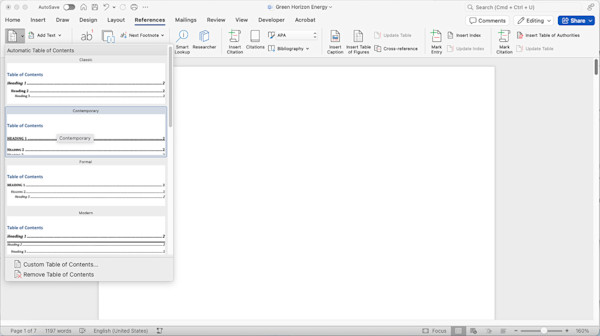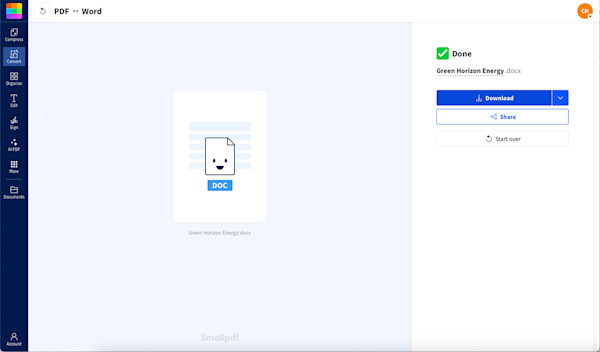
Add a table of contents to PDFs to make navigation a breeze, plus learn how to create a glossary, index, and sections for a polished document.
To add a table of contents to a PDF, create it in Microsoft Word using heading styles and the References tab, then save as PDF with “Create bookmarks using headings” enabled.
What Is a Table of Contents in a PDF?
A table of contents is a clickable guide that connects readers to different sections of your PDF.
Unlike a static contents page, a PDF table of contents uses clickable links that connect readers directly to different sections, eliminating endless scrolling. When it comes to training manuals, reports, and eBooks, a table of contents makes the document feel organized and professional.
How to Add a Clickable Table of Contents to a PDF Using Microsoft Word
Adding a table of contents (ToC) to a PDF starts with creating it in Word. If you’ve never done this before, don’t worry—this step-by-step guide will walk you through every detail.
Convert Your PDF to Word
Before you can add a ToC, you’ll need to work with an editable Word document. Use Smallpdf’s PDF to Word converter to make this switch. 1. Upload your document into our PDF to Word converter. 2. Wait a few seconds for the conversion to complete. 3. Download the converted Word—Simple!
Now you’re ready to work on your table of contents.
Apply Heading Styles in Word
A TOC works by recognizing heading styles in your document. Use Heading 1 for chapters, Heading 2 for sections, and Heading 3 for subsections. To set up these headings in Word: 1. Open your Word document. 2. Highlight the title of the first section or chapter. 3. Go to the Home tab on the Word toolbar. 4. In the “Styles” section, select Heading 1 for main sections. For subsections, use Heading 2 or Heading 3, depending on the structure you want. 5. Repeat this process for all titles and subtitles you want to appear in the table of contents.

Heading styles for creating a table of contents in Word
Using these predefined styles helps Word organize your document automatically when creating the ToC.
Insert the Table of Contents in Word
Once your headings are in place, adding the TOC is a breeze: 1. Place your cursor where you want the table of contents to appear—usually a blank page at the start of the document, right after the title page. 2. Go to the “References” tab on the Word toolbar. 3. Click the “Table of Contents” button. A dropdown menu will appear. 4. Choose a style from the menu. “Automatic Table 1” and “Automatic Table 2” are the most popular options.

Using Word to insert a table of contents
Word will now generate a table of contents based on the headings you applied earlier.
Update the Table of Contents in Word
If you make changes to your document—like adding sections or shifting content—your TOC won’t automatically update. Here’s how to refresh it after content changes: 1. Click anywhere inside the table of contents. 2. Select the Update Field option that appears at the top of the ToC. 3. Choose whether to update just the page numbers or the entire table. 4. Click OK, and Word will update the TOC to reflect your changes.

Completed table of contents
Save as PDF and Make Links Clickable
Once your table of contents is ready, it’s time to turn your Word document back into a PDF. You can do this directly in Microsoft Word by selecting “Save As” and changing the file format to PDF. Important: Always check “Create bookmarks using headings” in the Options dialog—this is the most commonly missed step that prevents clickable links.
Alternatively, you can use Smallpdf’s PDF converter: 1. Upload your DOCX document into our PDF converter. 2. The conversion will start automatically. 3. Download the newly converted PDF, now with your table of contents included.

Converting Word document with table of contents to PDF

Converting Word document with table of contents to PDF
And that’s it—you now have a polished PDF with a clickable, fully functional table of contents.
Fix Table of Contents Not Working in PDF
Running into issues with your PDF table of contents? Here are the most common problems and their quick fixes.
TOC Links Aren’t Clickable
Problem: The table of contents appears but the links don’t work when clicked.
Solution: Check your export settings. When saving from Word to PDF, make sure “Create bookmarks using headings” is enabled in the Options dialog. This setting creates the hyperlink targets that make your TOC clickable.
Page Numbers Don’t Match
Problem: The page numbers in your TOC don’t match where the sections actually appear.
Solution: Update your table of contents in Word before exporting to PDF. Also check if you have section breaks that might be affecting pagination.
Bookmarks Don’t Match the TOC
Problem: Your PDF has bookmarks, but they don’t align with your table of contents entries.
Solution: Regenerate bookmarks from headings in your PDF editor, or go back to Word and ensure your heading styles are consistent before re-exporting.
Best Practices for PDF Tables of Contents
Follow these tips to create professional, accessible table of contents that work perfectly every time:
- Keep heading levels consistent: Use Heading 1 for chapters, Heading 2 for sections, and Heading 3 for subsections throughout your document.
- Enable document structure tags: This makes your PDF accessible to screen readers and improves navigation for all users.
- Test your links: Always check that every TOC entry clicks through to the correct section before sharing your PDF.
- Use descriptive titles: Make sure your section headings clearly describe what readers will find in each part.
- Consider document length: For documents over 20 pages, both a TOC and bookmarks provide maximum navigation flexibility.
Add a Glossary for Specialized Terms
A glossary is ideal for technical or training PDFs where readers may not know certain terms.
- Create a new page titled Glossary near the end of your document.
- List important terms in alphabetical order.
- Add clear, one-sentence definitions.
- Use Word’s Hyperlink feature to connect each term to its first mention in the text.
- Export your file as a PDF with Create bookmarks using headings checked.
Add an Index for Quick Topic Lookup
An index makes it easy to find repeated terms or references across many pages.
- Highlight recurring words or phrases (e.g., “form fields,” “signatures”).
- Use Word’s Mark Entry feature to create main and sub-entries.
- Insert the index where you want it to appear—typically after the glossary.
- Export to PDF with links and bookmarks enabled.
Troubleshooting Index Issues
Missing Index Entries
Make sure every marked term is saved in the Word file before exporting. If you’ve converted from another format, re-mark any lost entries.
Links Not Working in PDF
Re-export with Create bookmarks using headings enabled. Without this option, hyperlink targets won’t carry over.
Page Numbers Not Matching Entries
Always Update Index in Word before saving as PDF. If the layout changed, refresh pagination to fix mismatched references.
Index Disappeared After Merging PDFs
Merge first using Merge PDF, then re-add or regenerate the index after combining. Merging can break internal cross-references.
How to Merge PDFs and Add a Table of Contents
Need to combine multiple PDFs and create one master table of contents? Here’s the complete workflow: 1. Use our Merge PDF tool to combine your documents into one file. 2. Convert the merged PDF to Word using our PDF to Word converter. 3. Add appropriate heading styles to each section from the original documents. 4. Insert a table of contents at the beginning using the References tab in Word. 5. Save as PDF with “Create bookmarks using headings” enabled.
This process ensures your merged file has a clickable and organized table of contents that covers all the original documents.
Editing, merging, or indexing your PDFs shouldn’t be a headache. With Smallpdf, you can convert, organize, split, and edit any document in one simple workspace—no installs, no fuss. Start your free trial today and see how easy professional PDF management can be.
PDF TOC: Frequently Asked Questions
Can I add a table of contents to a PDF on Mac Preview?
Mac Preview doesn’t support table of contents creation. Use Microsoft Word or Smallpdf’s conversion tools instead.
Can I create a table of contents directly in a PDF?
Most PDF viewers don’t support direct TOC creation. Convert to Word first or use bookmarks in a full PDF editor.
How do I fix TOC links that stop working after export?
Check that “Create bookmarks using headings” was enabled in your PDF export options—this is the most common cause.
Can I merge PDFs and keep a clickable table of contents?
Yes, merge your PDFs first using our Merge PDF tool, then convert to Word to add a master table of contents before converting back to PDF.
Can I add an index to a PDF?
Yes. Convert your PDF to Word, mark index entries under the References tab, and re-export as a PDF with Create bookmarks using headings turned on. You can also build an index manually in a PDF editor by linking keywords to page bookmarks.
What’s the difference between a table of contents and an index?
A table of contents lists document sections in reading order, while an index lists key terms alphabetically with page links. Use both for long manuals or reports. The table of contents helps with navigation, and the index helps with quick topic look-ups.
Can bookmarks act as an index?
Partly. Bookmarks create a clickable navigation list but don’t show page numbers or alphabetized terms. They work well for shorter PDFs or when you only need quick section jumps.



